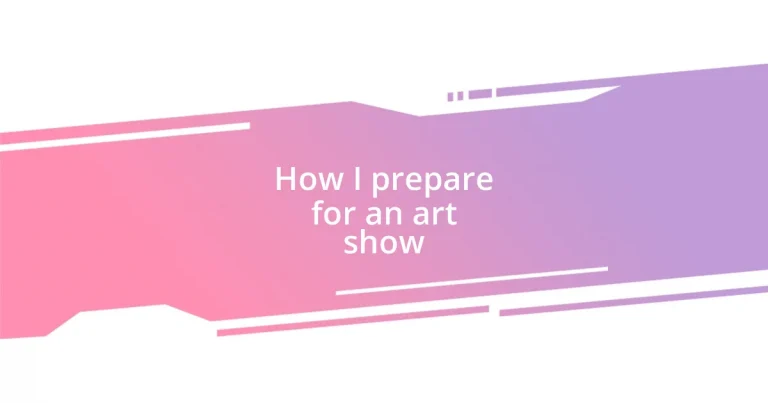Key takeaways:
- Setting clear goals for an art show enhances focus and transforms the event into a meaningful experience for both the artist and the audience.
- Thorough venue research, including understanding lighting and layout, is crucial for creating an engaging presentation that complements the artwork.
- Engaging with the audience through interactive elements and creating an inviting atmosphere fosters deeper connections and enriches the overall art show experience.
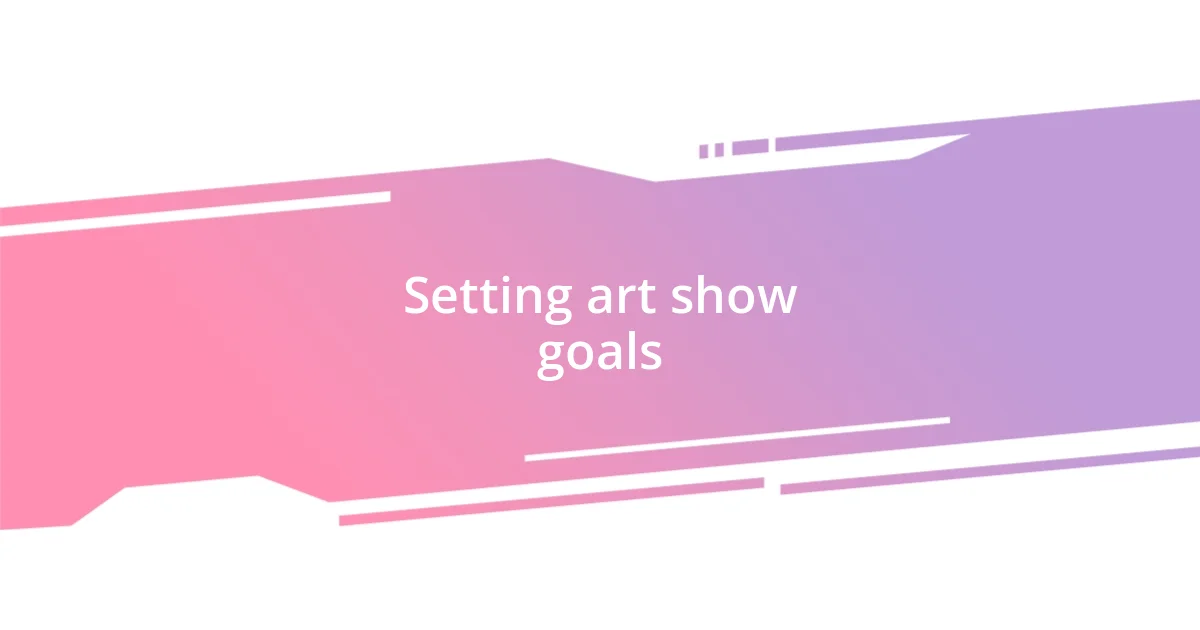
Setting art show goals
Setting clear goals for an art show is something I’ve learned to prioritize over the years. Every time I prepare for a show, I ask myself: “What do I want to achieve?” This might mean selling a certain number of pieces or simply creating a memorable experience for the attendees. I find that having these goals in mind keeps me focused and driven during the often-chaotic preparation process.
One year, I aimed to connect more deeply with my audience. Instead of just showcasing my artwork, I organized an interactive element where visitors could leave their thoughts on my pieces. This not only enriched the experience for them but also reignited my passion for creating art that resonates. It’s moments like these that remind me how meaningful goal-setting can be, transforming the art show from a simple exhibition to a personal dialogue.
Reflecting on your own aspirations can make the process feel more authentic. Have you thought about what success looks like for you? Whether it’s building your network, gaining recognition, or invoking emotions, defining your goals can guide your efforts and ultimately enhance your creative journey in ways you might not expect.

Researching the venue
When I research the venue for an upcoming art show, I find it invaluable to get a feel for the space. Each venue carries its own energy and atmosphere that can either enhance or detract from the viewer’s experience. I make it a point to visit the space beforehand, if possible, to envision how my pieces will interact with the environment. One venue I worked with had stunning natural light, which beautifully complemented my colorful works. However, I noticed that some areas were prone to reflections, so I adjusted my layout accordingly to minimize distractions.
Here are some key aspects I focus on during my venue research:
- Floor Plan: Understanding the layout helps me plan the placement of my artwork for optimal viewing.
- Lighting: I assess both natural and artificial lighting, watching how it plays off of textures and colors.
- Foot Traffic: Observing how guests move through the space can guide me in creating a flow that encourages engagement with my art.
- Amenities: Checking for facilities like restrooms and refreshment options can enhance the visitor experience.
- Accessibility: Ensuring my artwork is accessible to everyone is important, so I pay attention to ramps and furniture placement.
Each of these elements shapes the overall impact of the show. Once, in a more cramped venue, I struggled to make my larger pieces stand out. By focusing on these factors, I aim to create an inviting space where attendees feel drawn into my artistic world.
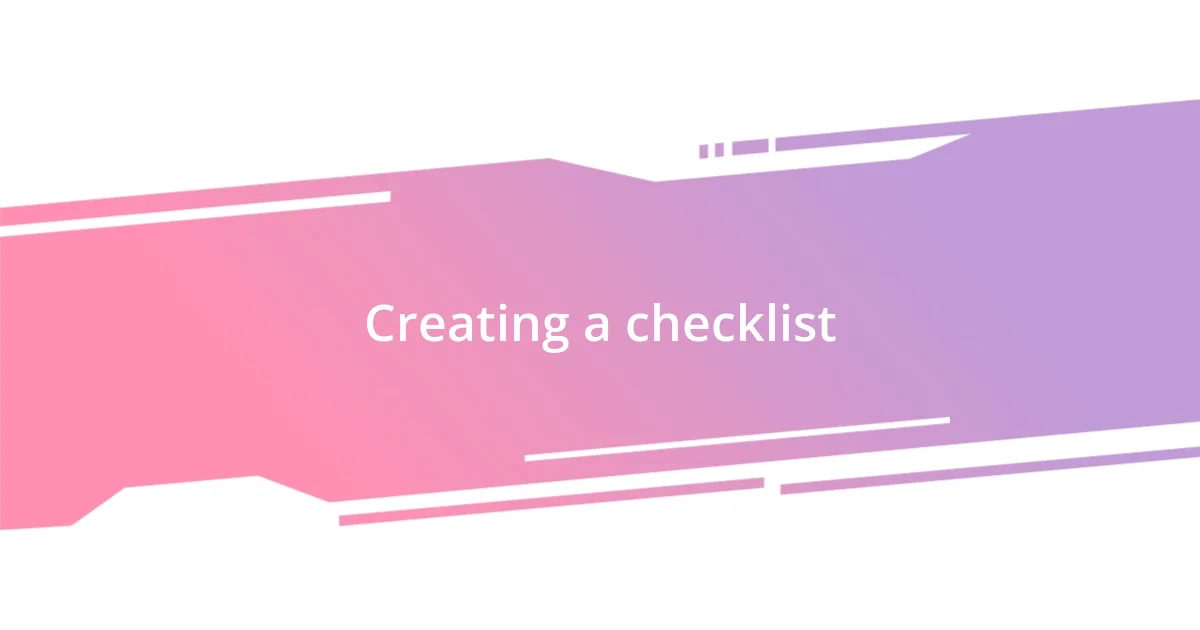
Creating a checklist
Creating a checklist is an essential part of my preparation for an art show. I start with broad categories to cover all aspects of the event, from artwork to marketing materials. It feels great to see everything laid out—it’s like a roadmap leading to the big day. By systematically ticking off each item, I alleviate a lot of that overwhelming uncertainty that comes with preparing for a show.
One aspect I find particularly helpful is breaking down each category into smaller tasks. For instance, under artwork, I’ll list specific pieces, their required framing, and any installation needs. This granular approach keeps me organized. It’s almost like gaining a sense of control amidst the chaos. I recall a time when I almost overlooked the need for business cards. Thankfully, a checklist reminded me in the nick of time, preventing a missed opportunity to connect with potential buyers.
Ultimately, I believe a well-crafted checklist not only streamlines preparation but also serves as a source of motivation. Each checkmark symbolizes a step closer to my artistic goals. Have you ever felt that rush of satisfaction when crossing off tasks? It’s not just about organization; it’s about building momentum and excitement for the big day.
| Checklist Categories | Examples |
|---|---|
| Artwork | List of pieces, framing requirements, installation materials |
| Marketing | Business cards, brochures, social media posts |
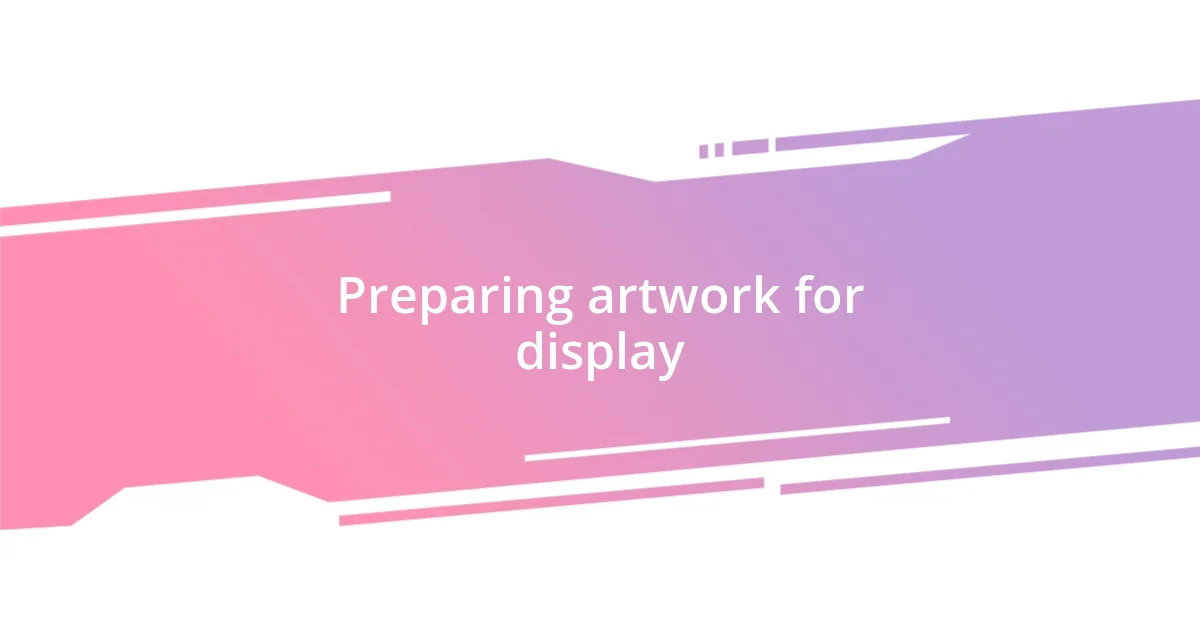
Preparing artwork for display
When it comes to preparing my artwork for display, I always think about presentation as an extension of the artwork itself. For instance, I carefully select the framing to enhance the piece, taking into account the colors and textures that will draw the viewer’s eye. I remember a time I chose a sleek black frame for a vibrant piece, and it truly made the colors pop. Have you ever had an experience where the framing changed your perception of a piece? It’s fascinating how such details can elevate the entire artwork.
As I prepare, I also pay close attention to the condition of each piece. I spend time cleaning them thoroughly, ensuring they look pristine. This might sound trivial, but nothing dampens the impact of a show quite like a dusty canvas. A few years back, I showed a collection after being a bit too rushed during setup, and I spotted a smudge on one of the canvases just moments before opening. I felt that panic wash over me. After that experience, I’ve learned to make cleaning part of my checklist. It’s those little touches that contribute to a powerful presentation.
Inventorying my artwork is another crucial step I never skip. I take detailed notes on each piece, including title, dimension, and price, creating a visual inventory that I find comforting. When exhibition day arrives, it’s satisfying to know each piece is accounted for and ready to shine. Once, I forgot to label one of my favorites, and while it was still appreciated, I felt it missed the chance to connect with viewers. Do you keep a record of your pieces? I’ve found that this practice not only keeps me organized but also tells the story of my journey as an artist.
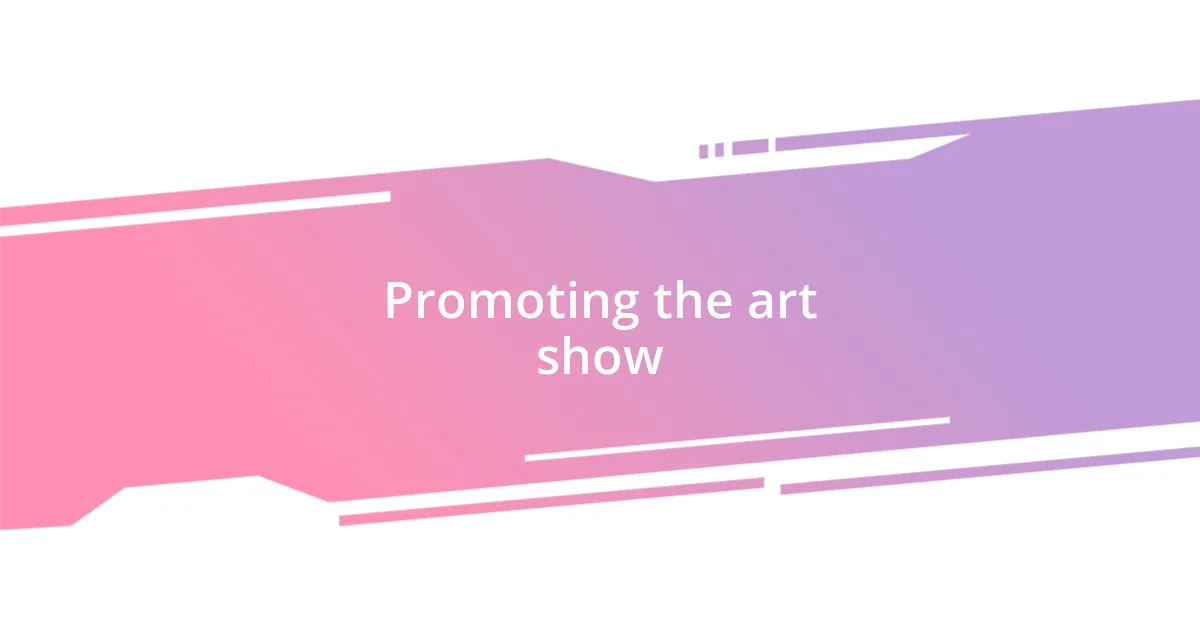
Promoting the art show
Promoting the art show is a critical piece of my preparation puzzle. Social media has become my best friend in this, allowing me to share sneak peeks of the art and my creative process. I remember the buzz I felt after posting a teaser image of a new piece—within hours, the comments and shares started pouring in. It’s incredible how digital engagement can build excitement and anticipation; have you ever felt that thrill of watching your community rally around your work?
Beyond online platforms, I always consider physical promotions as well. Printing eye-catching flyers and posting them in local cafes and galleries helps me connect with the art-loving crowd in my area. Once, I struck up a conversation with a barista who ended up becoming one of my biggest supporters, all because my flyer caught their eye. It’s amazing how a simple piece of paper can lead to meaningful connections—do you think printed material still holds value in a digital world?
Lastly, I find that collaborations with other local artists amplifies my reach. When we team up for joint promotions or host events together, it’s a win-win situation. At my last show, teaming up with a talented photographer not only brought in a diverse audience but also sparked conversations that I never anticipated. How do you feel about collaborating? In my experience, there’s something magical about pooling our resources and creativity to create a bigger impact.
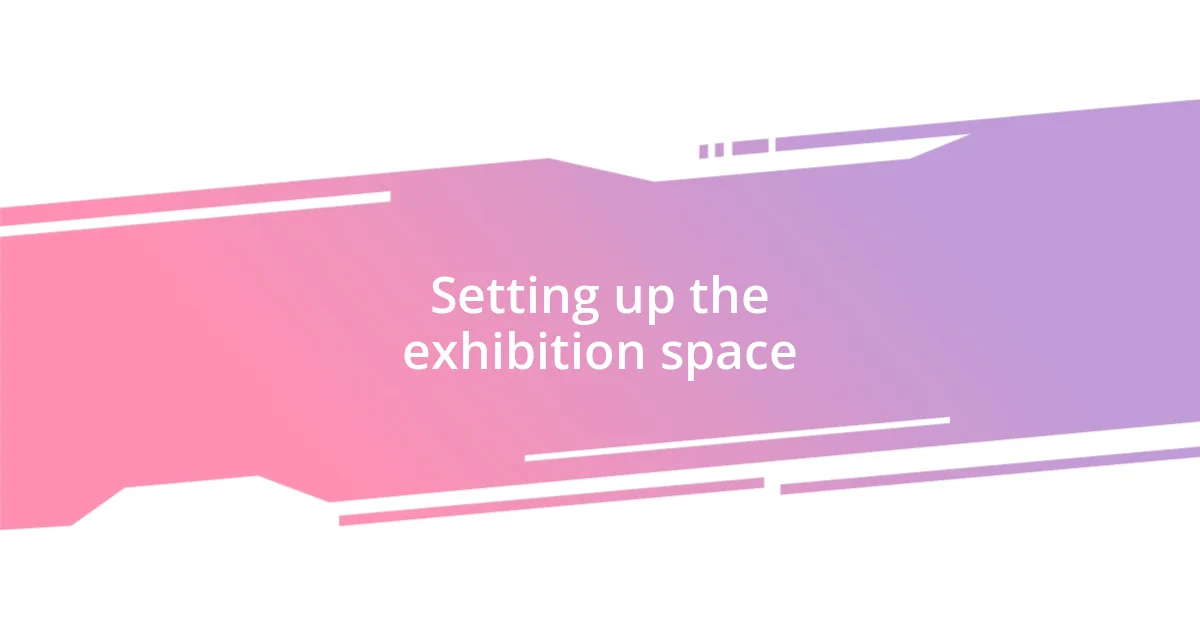
Setting up the exhibition space
When it comes to setting up the exhibition space, I believe the atmosphere of the venue is just as important as the artwork itself. I always arrive early to get a feel for the lighting and flow of the space. Once, at a gallery that had striking natural light, I realized how crucial it was to position pieces where they would glow without harsh glares. Have you considered how different lighting can change the mood of an exhibition? It’s fascinating to see how it impacts the viewer’s experience.
Choosing the right layout can make a world of difference, too. I often experiment with different arrangements—sometimes staggered, sometimes uniform—until the pieces speak to each other. I vividly recall a time when I created a diagonal pathway through my artworks; it drew people in and made them feel as though they were on a journey. Did you ever notice how certain layouts can guide viewers through a narrative? It’s all about inviting them to explore.
Lastly, I make it a point to leave ample space for viewers to engage with each piece. Cramming everything too closely can overwhelm, and I’ve learned this the hard way. At one show, I was so eager to display all my work that I felt the energy was off—people were hesitant to step forward. Since then, I prioritize breathing room in my setups. How do you approach spacing in your exhibitions? By giving viewers space to connect with each piece, I find they tend to linger longer, allowing each artwork to leave its mark.
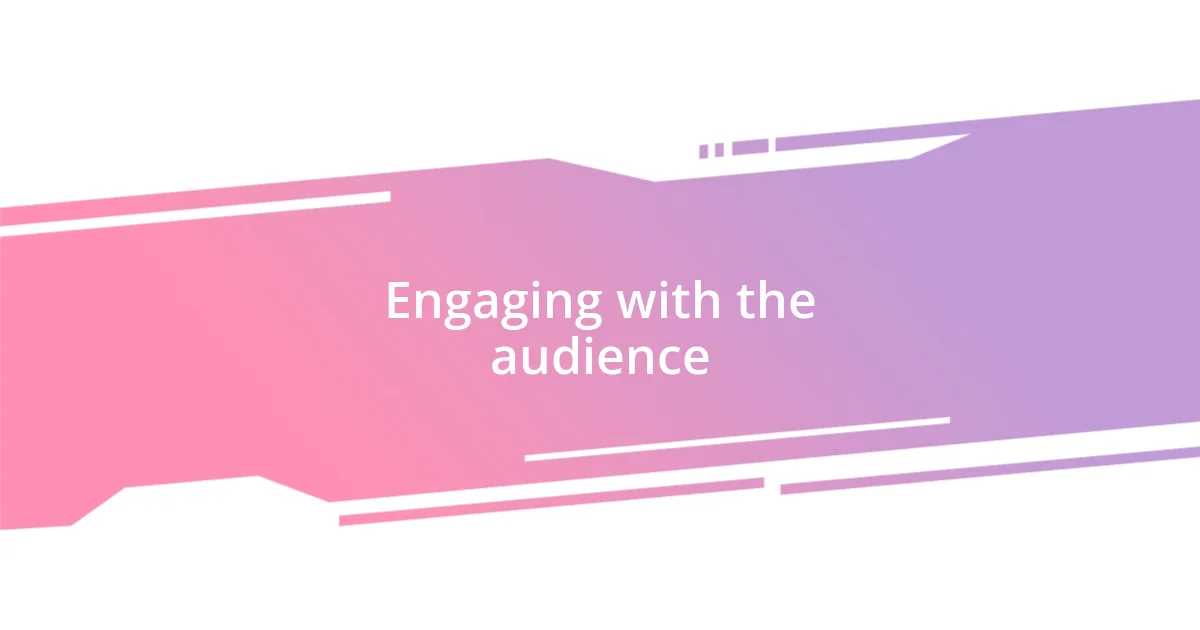
Engaging with the audience
Engaging with the audience is one of the most fulfilling aspects of preparing for an art show. I love watching the expressions on people’s faces as they react to my art; it’s a direct connection that makes all the hard work worthwhile. Once, a lady told me that a particular piece reminded her of her childhood home, and in that moment, I realized how my work could resonate with someone on such a personal level. Have you ever had a conversation with someone about art that shifted your perspective? Those moments create lasting bonds between artist and viewer.
I also believe in the power of active participation. For instance, during my last show, I hosted a live painting session, and it led to some amazing discussions with attendees. It became a two-way street; viewers shared their thoughts on the piece as it developed, and their insights inspired my techniques in real-time. Isn’t it incredible to consider how art can be a collaborative endeavor, engaging both creator and audience alike? I find those shared experiences often lead to a more memorable event.
Additionally, I focus on creating an inviting atmosphere where visitors feel comfortable approaching me. It’s a simple yet powerful approach. I recall at one show, I placed a small table with refreshments near my art. This seemed to lower the barrier for conversations—people would grab a drink and chat casually about their favorite pieces. Do you think offering something like that encourages engagement? In my experience, creating an environment that feels hospitable can inspire deeper discussions and lead to connections that go beyond the artwork itself.












